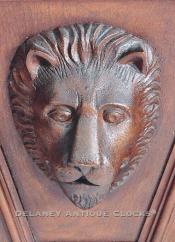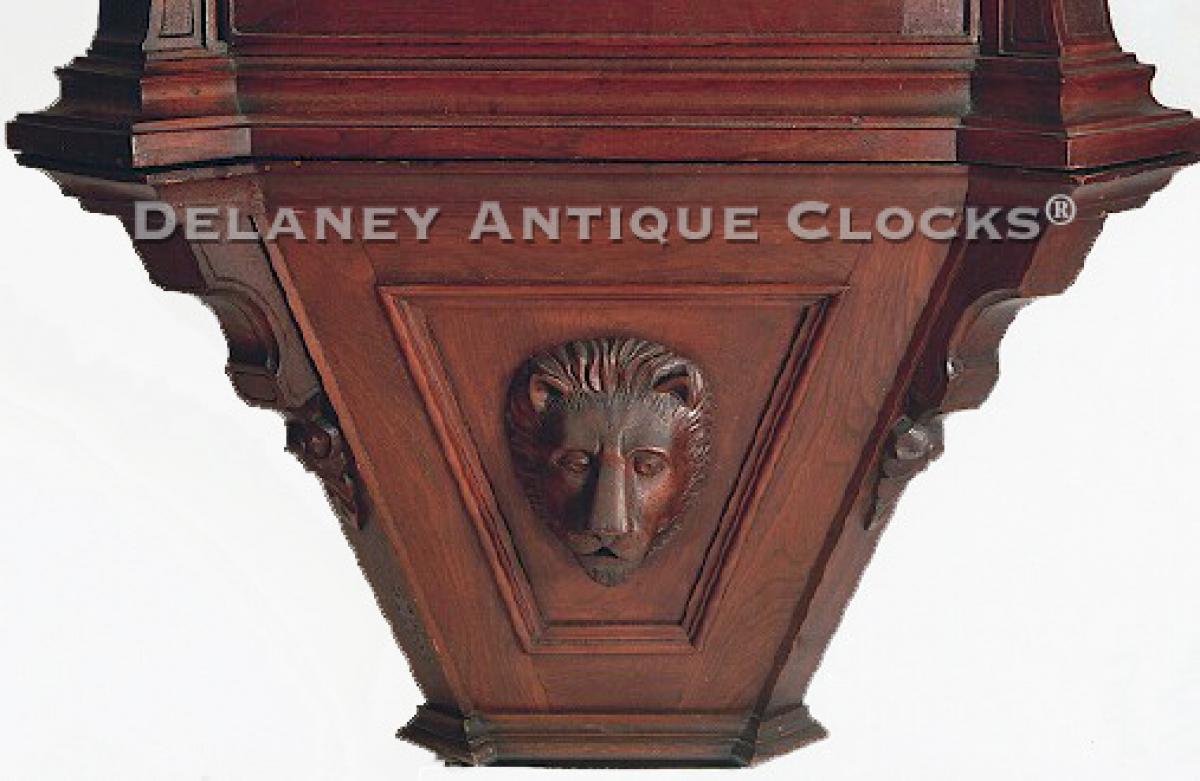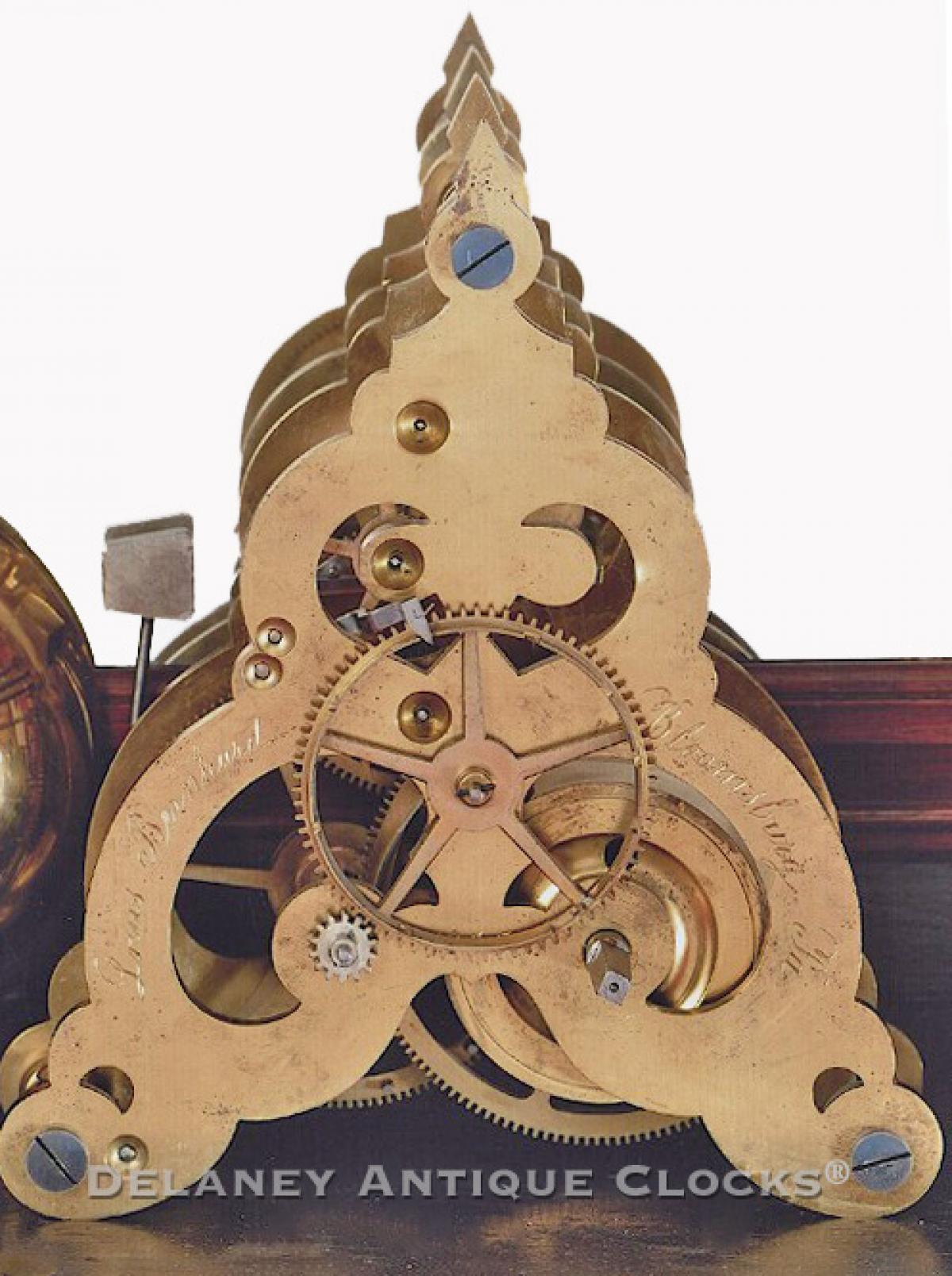Louis Bernhard. Clockmaker, Watchmaker, Jeweler, Artist and Architect working in Bloomsburg, Pennsylvania. This is a very unusual 30-day duration wall regulator. 219015.
This very impressive wall regulator was made in 1875 by Louis Bernhard of Bloomsburg, Pennsylvania. The design of which is a feast for the eyes.
The case is signed by the maker. A lead inscription on the backboard indicates that Bernhard completed this large regulator in 1875. He was not only the clockmaker but also the maker of this example. Bernard is known to have been a skilled woodworker. This case is constructed in black walnut and is highlighted with figured burl walnut veneers. The top is surmounted by a carved crest that features a bust depicting "Columbia," the goddess of Liberty. Two turned wooden finials are supported on wooden plinths. They are located on the front corners of the case. The bottom of the case is fitted with a bracket that tapers to a blunt point. This bracket is well-formed. The design incorporates applied moldings and a carved stylized lion's head. The waist section of the case is substantial. A full-length glass door fronts the cabinet. Long glass side lights are fitte4d into the sides. The door opens to access the interior of the case. Here a large mirror is fitted to the backboard and is secured with applied moldings.
The circular glass dial is fitted in a turned wooden bezel. The glass dial features Roman-style hour numerals and a subsidiary seconds dial. Because the dial is glass, one can view the movement behind it.
This thirty-day weight-powered movement features skeletonized plates that are decoratively engraved. The maker's name is also engraved on the front plate. This engraving reads, "Louis Bernhard, Bloomsburg, Pa." The movement also features a visible escape wheel which is front-mounted. The gravity escapement incorporates pivoted detent arms similar to "Reids spring pallet" escapement. This is regulated by a large single-faceted glass jar pendulum. The jar is filled with mercury, compensating for temperature. This pendulum is also signed and dated "Louis Bernhard / 1875." A separate movement used for the strike train is mounted at the bottom of the case. No surprise, The plates used here are also skeletonized and signed "Louis Bernhard, Bloomsburg, PA." This mechanism is designed with a front-mounted count-wheel strike system. The rear-mounted hammer strikes a bell mounted inside the case. A separate brass-cased weight powers this movement. It should be noted that this movement needs to be wound once a week.
This clock measures approximately 95 inches tall and is 32 inches wide.
Inventory number 219015.
Louis Bernhard is listed in several references as a watchmaker and jeweler working most of his life in Bloomsburg, Pennsylvania.
The (History of Columbia and Montour Counties Pennsylvania, Battle, 1887, Bloomsburg, pg. 323) provides the following information about this industrious person.
Louis Bernhard was born in Bavaria, Germany, in 1839. His family immigrated to America when he was a year old, settling in New York City. Within a few years, they moved West to Wilkes-Barre, Pennsylvania. Here he spent his childhood and was educated in the local town's school system. At the age of 17, Louis began an apprenticeship in the watch-making trade under the guidance of John F. Jordan. In 1858, Louis moved to the village of Bloomsburg, where he established his own watchmaker and jeweler business. He was talented and very skilled. In 1859, he exhibited a chronometer watch that he made at the Columbia County county fair. In fact, he claimed to have manufactured all of its parts. This is thought to have been the first watch ever made in the county. It is reported that he trained eleven apprentices in the watch trade during his residence in Bloomsburg. He is also said to have served the community as an architect and provided the plans for the Lowenberg & Cadman block, the Episcopal parsonage, and his residence, which was on Fifth Street. (It may be number 37 today?) Even the iron fence (now gone) surrounding his well-kept and ornamental grounds was cast from designs drawn and furnished by him. He also enjoyed oil painting and was a carver in both marble and wood. A few examples of his work survive. Examples include an elaborately finished case of black walnut housing an astronomical clock of most intricate and perfect workmanship, an elegant inlaid box for his drawing instruments, a large elaborately carved black walnut looking-glass frame, several oil paintings that included landscapes representing some of the choicest scenery in the vicinity of Bloomsburg, several copies of famous paintings, among them "Shakespeare and his Friends." All of these paintings are well executed and denote a high order of artistic skill. He has also painted oil portraits of himself and his wife and other members of his family. Mr. Bernhard was a resident of Bloomsburg for nearly thirty years. He is thought to have been progressive and public-spirited and has served this vicinity as a member of the council. He married Anna J. Townsend in April 1862. Together, they had six children. Mr. and Mrs. Bernhard were members of the Episcopal Church. He made a study of civil engineering at Wilkes-Barre Academy and completed his studies in New York City. (History of Columbia and Montour Counties Pennsylvania, Battle, 1887, Bloomsburg, pg. 323)
Other known articles include his wheel-cutting engine, which is in the William Penn Memorial Museum in Harrisburg. A floor-standing regulator made by him is in the NAWCC collection in Columbia, PA. This clock is described as a Regulator, having an eight-day time-only brass movement. It utilizes the escapement invented by Thomas Reid of Edinburgh, Scotland, in the early 1800s. The heavy brass plates are skeletonized and attached to a wooden seat board. The movement is engraved, "Louis Bernhard / Bloomsburg PA." The pendulum is a Harrison gridiron design. The bob is also engraved with "Louis Bernhard, Maker." The painted glass dial allows a view of the movement. It includes a subsidiary seconds dial. The walnut case is fitted with six glass panes. The interior is painted black, with his portrait behind the pendulum.


















